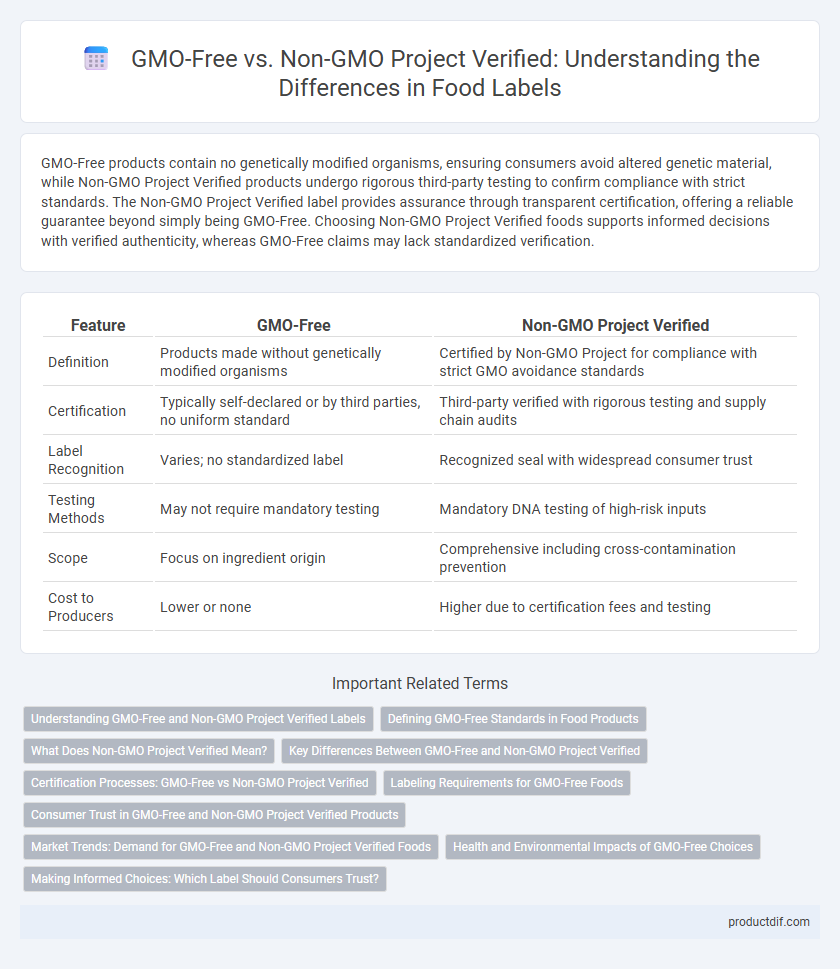GMO-Free products contain no genetically modified organisms, ensuring consumers avoid altered genetic material, while Non-GMO Project Verified products undergo rigorous third-party testing to confirm compliance with strict standards. The Non-GMO Project Verified label provides assurance through transparent certification, offering a reliable guarantee beyond simply being GMO-Free. Choosing Non-GMO Project Verified foods supports informed decisions with verified authenticity, whereas GMO-Free claims may lack standardized verification.
Table of Comparison
| Feature | GMO-Free | Non-GMO Project Verified |
|---|---|---|
| Definition | Products made without genetically modified organisms | Certified by Non-GMO Project for compliance with strict GMO avoidance standards |
| Certification | Typically self-declared or by third parties, no uniform standard | Third-party verified with rigorous testing and supply chain audits |
| Label Recognition | Varies; no standardized label | Recognized seal with widespread consumer trust |
| Testing Methods | May not require mandatory testing | Mandatory DNA testing of high-risk inputs |
| Scope | Focus on ingredient origin | Comprehensive including cross-contamination prevention |
| Cost to Producers | Lower or none | Higher due to certification fees and testing |
Understanding GMO-Free and Non-GMO Project Verified Labels
GMO-Free labels indicate products that do not contain genetically modified organisms, but lack standardized verification processes, making claims less consistent across brands. Non-GMO Project Verified seals require third-party testing and adherence to rigorous standards, ensuring transparent and reliable non-GMO certification for consumers. Understanding these distinctions helps shoppers make informed choices about product integrity and GMO content.
Defining GMO-Free Standards in Food Products
GMO-Free refers to food products that contain no genetically modified organisms, emphasizing the complete absence of biotech alterations in their ingredients. The Non-GMO Project Verified label is a third-party certification that ensures rigorous testing and traceability protocols are met to confirm non-GMO status. These standards prioritize transparency and consumer trust by verifying ingredients through stringent audits and supply chain controls.
What Does Non-GMO Project Verified Mean?
Non-GMO Project Verified indicates that a product has undergone rigorous third-party testing and meets strict standards for avoiding genetically modified organisms. This verification ensures transparency and commitment to non-GMO sourcing, providing consumers with confidence in the product's ingredient integrity. The Non-GMO Project label specifically addresses genetic modification in crops and ingredients, distinct from general GMO-free or organic claims.
Key Differences Between GMO-Free and Non-GMO Project Verified
GMO-Free indicates a product contains no genetically modified organisms, but standards can vary by region and certification body. Non-GMO Project Verified is a third-party certification with rigorous testing, traceability, and compliance requirements to ensure products meet strict non-GMO standards. The key difference lies in the verification process, where Non-GMO Project Verified provides a transparent, trusted label supported by ongoing monitoring and audits.
Certification Processes: GMO-Free vs Non-GMO Project Verified
GMO-Free certification typically involves a manufacturer's self-declaration or basic testing to confirm the absence of genetically modified organisms, whereas Non-GMO Project Verified requires rigorous third-party testing, traceability, and compliance with strict standards throughout the supply chain. The Non-GMO Project's certification process includes ongoing inspections and random testing to ensure transparency and consumer trust. GMO-Free labels may vary in credibility due to less standardized verification, making Non-GMO Project Verified one of the most trusted certifications in the food industry.
Labeling Requirements for GMO-Free Foods
GMO-Free labeling typically means a product contains no genetically modified organisms but lacks standardized regulatory oversight, leading to varied claims across manufacturers. Non-GMO Project Verified requires rigorous third-party verification with strict testing protocols and supply chain traceability to ensure compliance with non-GMO standards. These labeling requirements impact consumer trust, with the Non-GMO Project providing a more transparent and reliable certification for GMO-free foods.
Consumer Trust in GMO-Free and Non-GMO Project Verified Products
Consumer trust in GMO-Free and Non-GMO Project Verified products hinges on clear labeling and rigorous verification processes that ensure transparency and authenticity. Non-GMO Project Verified products undergo independent third-party testing to meet strict standards, which enhances consumer confidence in avoiding genetically modified organisms. Conversely, GMO-Free claims often rely on manufacturer assertions without standardized verification, potentially leading to skepticism among health-conscious consumers seeking reliable assurances.
Market Trends: Demand for GMO-Free and Non-GMO Project Verified Foods
Market trends indicate a significant increase in consumer demand for GMO-free and Non-GMO Project Verified foods, driven by growing health consciousness and environmental concerns. Retail sales of Non-GMO Project Verified products have surged, reflecting a 20% annual growth in North America alone. Food manufacturers are expanding GMO-free product lines to meet this rising consumer preference and capture market share.
Health and Environmental Impacts of GMO-Free Choices
GMO-Free foods avoid genetically modified organisms, potentially reducing exposure to synthetic pesticides and supporting biodiversity by preventing cross-contamination with native species. Non-GMO Project Verified products undergo rigorous third-party testing to ensure compliance with strict GMO avoidance standards, enhancing consumer trust and promoting sustainable agricultural practices. Choosing GMO-Free and Non-GMO Project Verified foods contributes to healthier ecosystems and may reduce health risks associated with GMO consumption.
Making Informed Choices: Which Label Should Consumers Trust?
GMO-Free labels indicate a product contains no genetically modified organisms, offering a general assurance, while Non-GMO Project Verified certification involves rigorous third-party testing and compliance with strict standards ensuring non-GMO ingredients. Consumers seeking transparency and verified authenticity should preferentially trust the Non-GMO Project Verified label due to its comprehensive verification process. Understanding the differences between these labels enables informed decisions aligned with personal health and environmental values.
GMO-Free vs Non-GMO Project Verified Infographic

 productdif.com
productdif.com